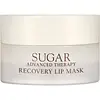What's inside
What's inside
 Key Ingredients
Key Ingredients

 Benefits
Benefits

 Concerns
Concerns

 Ingredients Side-by-side
Ingredients Side-by-side

Isononyl Isononanoate
EmollientPolybutene
C10-30 Cholesterol/Lanosterol Esters
EmulsifyingBis-Diglyceryl Polyacyladipate-2
EmollientDiisostearyl Malate
EmollientPolyethylene
AbrasiveIsostearyl Isostearate
EmollientHydrogenated Polyisobutene
EmollientVitis Vinifera Seed Oil
EmollientRhus Verniciflua Peel Wax
Ethylene/Propylene/Styrene Copolymer
Vinyl Dimethicone/Methicone Silsesquioxane Crosspolymer
Butyrospermum Parkii Butter
Skin ConditioningButyrospermum Parkii Butter Unsaponifiables
Skin ConditioningSucrose Tetrastearate Triacetate
EmollientRibes Nigrum Seed Oil
EmollientTocopherol
AntioxidantAscorbyl Palmitate
AntioxidantParfum
MaskingButylene/Ethylene/Styrene Copolymer
Ammonium Glycyrrhizate
MaskingEthylhexyl Palmitate
EmollientVanillin
MaskingPentaerythrityl Tetra-Di-T-Butyl Hydroxyhydrocinnamate
AntioxidantTrihydroxystearin
Skin ConditioningSodium Hyaluronate
HumectantLimonene
PerfumingCitral
PerfumingBenzyl Alcohol
PerfumingLinalool
PerfumingIsononyl Isononanoate, Polybutene, C10-30 Cholesterol/Lanosterol Esters, Bis-Diglyceryl Polyacyladipate-2, Diisostearyl Malate, Polyethylene, Isostearyl Isostearate, Hydrogenated Polyisobutene, Vitis Vinifera Seed Oil, Rhus Verniciflua Peel Wax, Ethylene/Propylene/Styrene Copolymer, Vinyl Dimethicone/Methicone Silsesquioxane Crosspolymer, Butyrospermum Parkii Butter, Butyrospermum Parkii Butter Unsaponifiables, Sucrose Tetrastearate Triacetate, Ribes Nigrum Seed Oil, Tocopherol, Ascorbyl Palmitate, Parfum, Butylene/Ethylene/Styrene Copolymer, Ammonium Glycyrrhizate, Ethylhexyl Palmitate, Vanillin, Pentaerythrityl Tetra-Di-T-Butyl Hydroxyhydrocinnamate, Trihydroxystearin, Sodium Hyaluronate, Limonene, Citral, Benzyl Alcohol, Linalool
Water
Skin ConditioningHydrogenated Polyisobutene
EmollientGlycerin
HumectantCera Microcristallina
Emulsion StabilisingDimethicone
EmollientUndecane
EmollientTridecane
PerfumingPEG/PPG-18/18 Dimethicone
EmulsifyingSilica
AbrasiveAlcohol Denat.
AntimicrobialTocopheryl Acetate
AntioxidantPolymethylsilsesquioxane
Ethylhexyl Palmitate
EmollientPhenoxyethanol
PreservativeLauryl PEG-9 Polydimethylsiloxyethyl Dimethicone
Skin ConditioningTocopherol
AntioxidantMagnesium Sulfate
Disteardimonium Hectorite
StabilisingGlucosamine Hcl
Tribehenin
EmollientCaprylyl Glycol
EmollientAllantoin
Skin ConditioningDisodium EDTA
Hydroxyethyl Urea
HumectantSorbitan Isostearate
EmulsifyingSodium Hyaluronate
HumectantFaex Extract
Skin ConditioningBiosaccharide Gum-1
HumectantPalmitoyl Oligopeptide
CleansingSilybum Marianum Extract
Skin ConditioningCeramide AP
Skin ConditioningWater, Hydrogenated Polyisobutene, Glycerin, Cera Microcristallina, Dimethicone, Undecane, Tridecane, PEG/PPG-18/18 Dimethicone, Silica, Alcohol Denat., Tocopheryl Acetate, Polymethylsilsesquioxane, Ethylhexyl Palmitate, Phenoxyethanol, Lauryl PEG-9 Polydimethylsiloxyethyl Dimethicone, Tocopherol, Magnesium Sulfate, Disteardimonium Hectorite, Glucosamine Hcl, Tribehenin, Caprylyl Glycol, Allantoin, Disodium EDTA, Hydroxyethyl Urea, Sorbitan Isostearate, Sodium Hyaluronate, Faex Extract, Biosaccharide Gum-1, Palmitoyl Oligopeptide, Silybum Marianum Extract, Ceramide AP
 Reviews
Reviews

Alternatives
Ingredients Explained
These ingredients are found in both products.
Ingredients higher up in an ingredient list are typically present in a larger amount.
Ethylhexyl Palmitate, also known as octyl palmitate, is created from 2-ethylhexyl alcohol and palmitic acid. It is a fatty acid ester.
The fatty acid content of Ethylhexyl Palmitate makes it an emollient. Emollients help soften and hydrate your skin by trapping moisture within.
Ethylhexyl Palmitate is also used to help improve the texture of cosmetics. It helps other ingredient dissolve in products and help disperse ingredients more evenly.
You'll likely find this ingredient in sunscreen, as it is often used to mix UV-blocking ingredients such as avobenzone and ethylhexyl triazone.
It can also help stabilize the fragrances in a product as a fragrance fixative.
Ethylhexyl Palmitate can be used to substitute mineral oil.
Due to its high fatty acid content, it may not be fungal-acne safe.
Learn more about Ethylhexyl PalmitateHydrogenated Polyisobutene is a synthetic polymer. Polymers are compounds with high molecular weight. Hydrogenated Polyisobutene is an emollient and texture enhancer.
In one study, Hydrogenated Polyisobutene showed better skin hydration levels than Caprylic/Capric Triglyceride. As an emollient, it helps keep your skin soft and hydrated by trapping moisture in.
Hydrogenated Polyisobutene is often used as a mineral oil replacement.
Learn more about Hydrogenated PolyisobuteneSodium Hyaluronate is hyaluronic acid's salt form. It is commonly derived from the sodium salt of hyaluronic acid.
Like hyaluronic acid, it is great at holding water and acts as a humectant. This makes it a great skin hydrating ingredient.
Sodium Hyaluronate is naturally occurring in our bodies and is mostly found in eye fluid and joints.
These are some other common types of Hyaluronic Acid:
Learn more about Sodium HyaluronateTocopherol (also known as Vitamin E) is a common antioxidant used to help protect the skin from free-radicals and strengthen the skin barrier. It's also fat soluble - this means our skin is great at absorbing it.
Vitamin E also helps keep your natural skin lipids healthy. Your lipid skin barrier naturally consists of lipids, ceramides, and fatty acids. Vitamin E offers extra protection for your skin’s lipid barrier, keeping your skin healthy and nourished.
Another benefit is a bit of UV protection. Vitamin E helps reduce the damage caused by UVB rays. (It should not replace your sunscreen). Combining it with Vitamin C can decrease sunburned cells and hyperpigmentation after UV exposure.
You might have noticed Vitamin E + C often paired together. This is because it is great at stabilizing Vitamin C. Using the two together helps increase the effectiveness of both ingredients.
There are often claims that Vitamin E can reduce/prevent scarring, but these claims haven't been confirmed by scientific research.
Learn more about Tocopherol